AUCTORES
Globalize your Research
Research Article
*Corresponding Author: Hanan Elzeblawy Hassan, Maternal and Newborn Health Nursing, Faculty of Nursing, Beni-Suef University, Egypt.
Citation: Hanan E. Hassan, Fatima H. A. ELhakam, Rasha E. S. Ebrahim, Momen Z. Mohammed. (2023). Female Genital Mutilation: Females' Intention in Northern Upper Egypt. J. Obstetrics Gynecology and Reproductive Sciences, 7(1) DOI: 10.31579/2578-8965/144
Copyright: © 2023 Hanan Elzeblawy Hassan, This is an open-access article distributed under the terms of The Creative Commons Attribution License, which permits unrestricted use, distribution, and reproduction in any medium, provided the original author and source are credited.
Received: 21 November 2022 | Accepted: 23 December 2022 | Published: 08 February 2023
Keywords: female genital mutilation; intention; northern upper Egypt
Background: Female Genital Mutilation/Cutting is an ancient cultural practice, predating the Bible and therefore the Koran, and has no basis in any religion. It is related to deep social and cultural ideas impeded in several societies regarding femininity and modesty because it is viewed as girls clean and delightful only after being genitally cut. FGM/C is additionally viewed as a protection of virginity, and it prevents premarital sex.
Aim: The present study was carried find out to assess Females' Intention in Northern Upper Egypt regarding Female Genital Mutilation.
Subject & Methods: A Descriptive Cross-sectional study was used. The study was conducted in family health centers (FHCs) in different sitting at Beni-Suef Governorate. A Convenient sample was used. А Structured Interviewing Questionnaire sheet which includes three sections: Socio-demographic data, Intention to practice FGM/C, and Causes for intention or not to practicing FGM/C.
Results: The mean age of the studied participants was 22.6±5. Prevalence of Female Genital Mutilation is 71.4percentage, 29.7percentage of participants are suffering from complications after FGM. About 28.6percentage of females who had mutilated their daughters were planning to mutilate their other daughters in the future. More than one-third of females (35.5percentage) had an unfavorable attitude and 40.5percentage had poor levels of knowledge regarding FGM/C. 71.3percentage of females mentioned that the source of their information about FGM/C was their personal experience.
Conclusion: Northern Upper Egyptian Females' Intention regarding intention of mutilating their daughters was significantly affected by demographic characteristics, level of knowledge, and level of attitude, source information, exposure to complications or pressure from family and neighbors.
Recommendations: Alleviate females' intention toward Female Genital Mutilation should be improving their awareness regarding complications and Egyptian law against FGM, established by improve females' resistance toward family or neighbor regarding bad and harmful traditions.
The terms female genital cutting (FGC) and female genital mutilation/cutting (FGM/C) are often used among practicing communities and individuals. These concepts emphasize the significance of adopting nonjudgmental vocabulary when working with practitioners. When discussing the matter in practice communities, terms like excision or genital cutting are also acceptable [1-7].
The FGM/C is an ancient cultural practice, predating the Bible and therefore the Koran, and has no basis in any religion [8-10]. FGM/C is related to deep social and cultural ideas impeded in several societies regarding femininity and modesty because it is viewed as girls clean and delightful only after being genitally cut. FGM/C is additionally viewed as a protection of virginity, and it prevents premarital sex [11-15].
Sociological causes include what's called “rite de passage” which suggests a transition within the stage of life from girlhood to womanhood and the entrance of the females to the wedding age. These traditions and social norms pass between generations resulting in the continuation of the practice. Psychological causes involve the thought of danger. Some tribes consider the clitoris to be a dangerous organ that has got to be removed. Others see that the removal of the sensitive genital tissues curbs sexual pleasure which successively preserves virginity and chastity and maintains the fidelity of females [16-20].
In Belgium, a study conducted to estimate the number of females who had experienced FGM/C found that 27.4percentage of immigrant females living in Belgium had undergone FGM/C and 8.7percentage of the females were in danger of experiencing FGM/C [21-23].
In Germany, 30percentage of immigrant females from Sub-Saharan Africa had experienced FGM/C before moving to Europe [24-26].
Preventive Strategies of FGM/C:
The eradication of FGM/C necessitates, so WHO reported preventive strategies through three diminutions [28]. (1) Multi-sector: addressing a wide range of issues at multiple levels, including education, justice, finance, women's issues, and health. (2) Sustained: have a long-term impact because progress can be slow. (3) Community-directed projects: have projects driven by communities to assist them in identifying problems, issues, and interventions. These projects aimed at ending FGM/C are non-judgmental and enable people to make their own decisions about whether or not to continue with the practice.
Seven things can be done to assist communities to abandon FGM/C: [29]
Egyptian Strategies & Law for FGM/C prohibition:
First: - the laws:
In 1996, the Ministry of Health issued a decree-law prohibiting the practice of female circumcision, based on the criminal law, which prohibits harm to the body of humans except under medical controls. It should be noted that the criminalization of FGM officially began in 2008 when the Egyptian People’s Assembly (currently the House of Representatives) passed a law punishing the perpetrators of the crime with a fine and imprisonment ranging from three months to two years.
Second: The Legislative Position on Female Genital Mutilation
When the Child Law was amended by Law No. 126 of 2008, the text of Article 242 was added to the Penal Code to toughen the punishment for an intentional wound if it occurred through “female circumcision.”
The new law contains two important articles
Article One: A number of recent legal amendments to the article of the Penal Code relating to female genital mutilation were approved in accordance with Law No. 78 of 2016, which was published in the Official Gazette on September 26, 2016. Article 242 of the Penal Code reads: “A penalty of imprisonment for a period of no less than five Years and not more than seven years for anyone who performs female circumcision by partially or completely removing any of the external genitalia or inflicting injuries on those organs without medical justification".
The penalty shall be hard labor for a period of no less than five years if the person who performs the circumcision referred to in the previous paragraph is a doctor or a practitioner of the profession of nursing. If his crime results in a permanent disability, the penalty shall be aggravated imprisonment for a period of no less than ten years; Temporary imprisonment for a period of no less than fifteen years and not more than twenty years.
In addition to the aforementioned penalties, the court shall decide to deprive its perpetrator, doctors and nurses, of practicing the profession for a period of no less than three years and not more than five years, beginning after the end of the period of execution of the penalty, and the closure of the private facility where the circumcision was performed.
** Replaced by Law No. 10 of 2021 published in the Official Gazette on 4/28/2021
As for the second article, it added to the Penal Code an updated text for the first time, which is the text of Article 242 (a). Anyone who requests female circumcision and it was circumcised at his request, as stipulated in Article 242 of this law, shall be punished with imprisonment.
Anyone who promotes or encourages, or calls in one of the ways set forth in Article (171) of this law to commit the crime of female circumcision, even if there is no effect from his action, shall be punished by imprisonment.
** Replaced by Law No. 10 of 2021 published in the Official Gazette on 4/28/2021
The present study was carried find out to assess Females' Intention in Northern Upper Egypt regarding Female Genital Mutilation
3.1. Research Design: A Descriptive Cross-sectional study was used in the current study.
3.2. Subjects & Setting:
3.2.1. Setting: The study was conducted in family health centers (FHCs) in different sitting at Beni-Suef Governorate. Beni-Suef governorate is divided into seven sectors. From every sector the MCH was randomly selected to geographically represent the sector. As the following mention:
At Beni-Suef sector Salah Salem MCH and Eastern MCH. At Nasser sector Taha Bosh MCH was selected, Beba sector Beba Medical Center and Tarshoup MCH was selected. While Fashen sector Bani Saleh MCH was selected. At Somesta sector Al-shantour MCH was selected. Ehnasia sector El- Mamalik MCH and Elnouira MCH. While Elwasta sector Kamen El-Arouse MCH was selected.
3.2.2. Sample:
3.2.2.1. Sample Type:
A Convenient sample was used.
3.2.2.2. Sample size:
The study population consisted of all females who were accepted to participate in the study at the time of data collection (A period of six months from the start of data collection) and will be included in the study.
3.3 Tools of Data Collection:
A pre-designed structured questionnaire was used to collect data. Data were collected through personal interviews. The questionnaire is divided into three sections:
Section I: А Structured Interviewing Questionnaire sheet which includes the following parts: age, residence, level of education, marital status, occupation and experience with mutilation, etc……
Section II: Intention to practice FGM/C: It included questions about the following:
Section III: Females' Causes for Intention or not to Practicing FGM/C
3.5 Validity & Reliability of the Tool
Α panel of 3 experts in the field of maternity, Obstetrics and Gynecologic Nursing reviewed the tool to test its content validity. Modifications were done accordingly based on their judgment. The reliabilities of the tool were biased on of Cronbаch Αlphа.
3.6. Administrative & Ethical Considerations:
Official permission was obtained by submission of an official letter from the Faculty of Nursing, Beni-Suef University, to the responsible authorities of the study setting to obtain their permission for data collection for the study. All ethical issues were taken into consideration during all the phases of the study; the researcher maintained the anonymity/confidentiality of the women.
The researcher introduced herself to every woman and briefly explained the nature, and the objectives of the study before participation. Participant women were enrolled voluntarily after the oral informed consent.
3.7. Pilot Study
The pilot study was carried out on 10percentage of the studied women in the study setting (that were excluded from)
3.8. Field Work
Data were gathered over six months beginning in November 2021 and ending in April 2022.
3.9. Statistical Analysis
All data were collected, tabulated and statistically analyzed using IBM SPSS 25. Data was supplied, and appropriate analysis was performed for each parameter based on the type of data obtained.
3.9.1. Descriptive Statistics data were expressed as:
3.9.2. Analytical Statistics:
3.9.3. Graphical presentation:
Table (1) showed that the mean age of the studied participants was 22.6±5, most of them were rural residents (70.4percentage), 90.2percentage were highly educated, 57.5percentage were single, 96.8percentage were Muslims, and most of their mothers were educated (72.8percentage), and most of their fathers were educated (83.2percentage). About two-thirds of the participants were a student (65.4percentage).
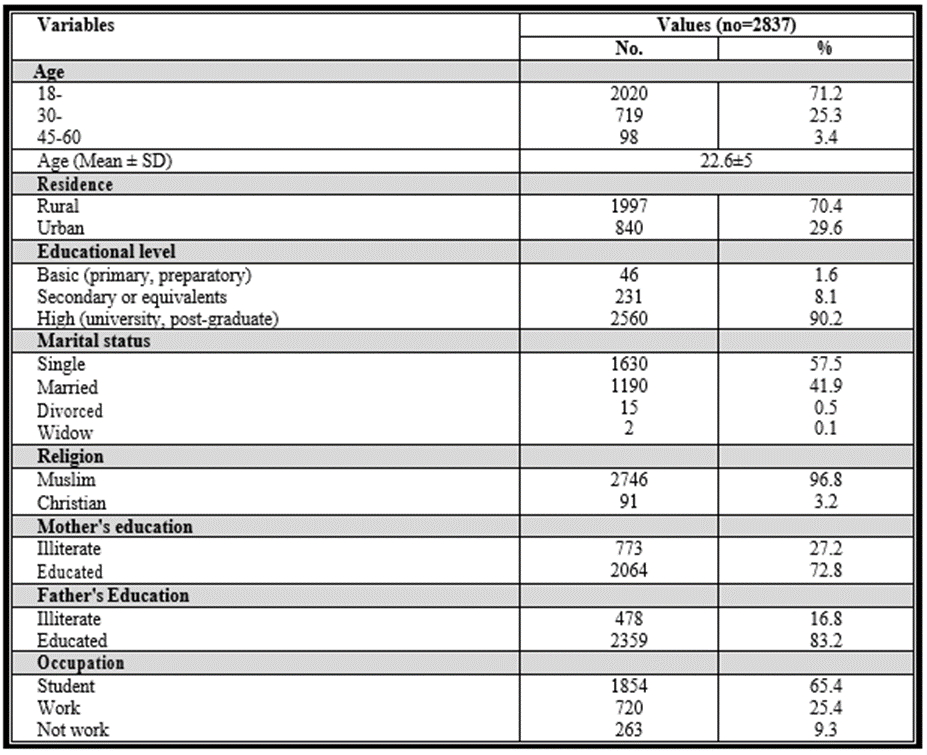
Table (1): Socio-Demographic Characteristics & of the Studied Participants.
Figure (1) presents that the prevalence of Female Genital Mutilation (FGM/C) among total participants (2837) at Beni-Suef is 71.4percentage.

Figure (1): Prevalence of female genital mutilation/cutting.
Figure (2) Presents participants' intention to perform FGM for their sister or daughter. About 28.6percentage of females who had mutilated their daughters were planning to mutilate their other daughters in the future.

Figure (2): Participants' Intention to perform FGM for their sister or daughter.
Table (2) showed Significant statistical relationship between participants' intention of mutilating their daughters and demographic & personal characteristics (plessthan0.001).
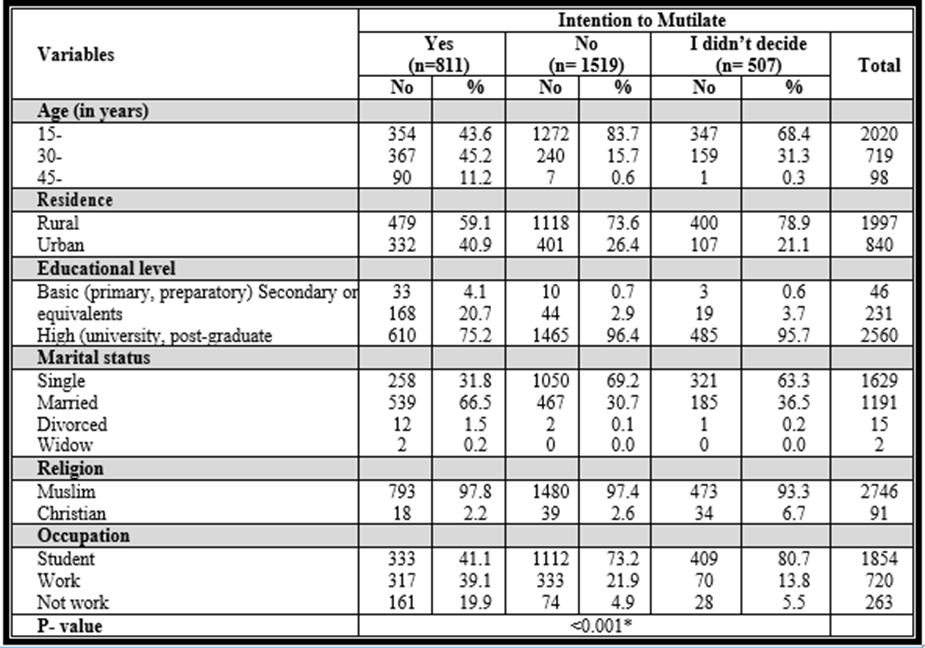
Table (2): Relationship between Females' Intention of Mutilating their daughters and Demographic & Personal Characteristics
*P-value is significant (plessthan0.001)
Table (3) presents the distribution of sample according to their total knowledge score. Only 25.7percentage of females had good knowledge regarding FGM/C, while 40.5percentage and 33.8percentage had poor and fair levels of knowledge.

Table (3): Total Knowledge Scores among the Studied Participants.
Table (4) describes the percent of the distribution of females according to their total attitude score towards FGM/C. More than one-third of females (35.5percentage) had an unfavorable attitude towards (supporting) FGM/C and 44.3 percentage of them had a favorable attitude towards (refusing) FGM/C while 20. 2percentage had a neutral attitude.

Table (4): Attitude categories among the studied participants.
Table (5) presents significant statistical relationship between females' intention of mutilating their daughters and their mutilation experience, level of knowledge, and level of attitude (plessthan0.001).
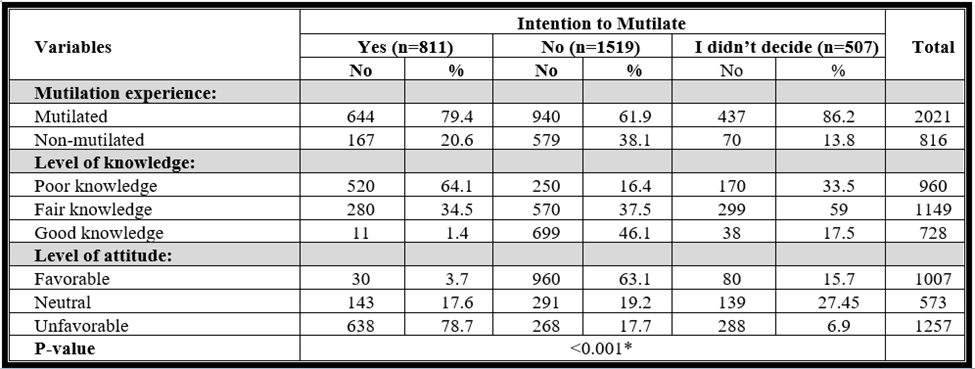
Table (5): Relationship between Females' Intention of Mutilating their daughters and their Mutilation Experience, Level of Knowledge, and Level of Attitude
*P-value is significant (plessthan0.001)
Figure (3) portrays the distribution of females according to their source of information regarding FGM/C. About 71.3percentage of females mentioned that the source of their information about FGM/C was their personal experience, 36.2percentage from friends or neighbors, and 22percentage from TV or radio.
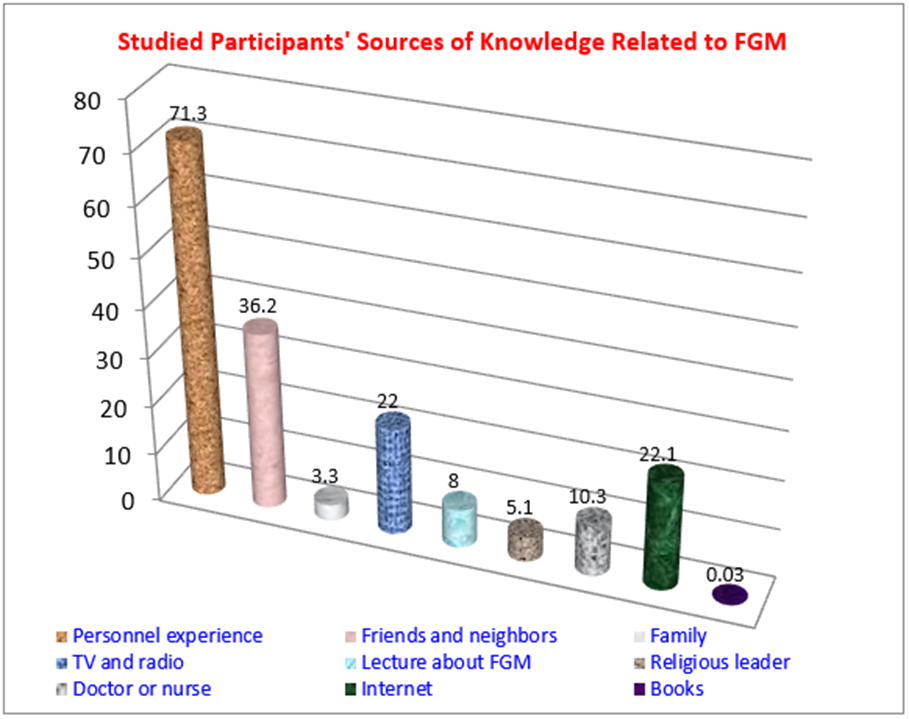
Figure (3): Sources of information regarding FGM among the Studied Participants.
Table (6) shows a significant statistical relationship between women's intention to circumcise their daughters and their source information (plessthan0.001).
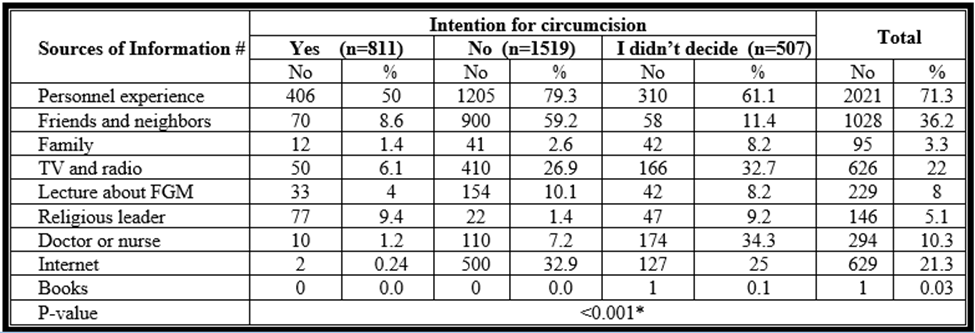
Table (6): Relationship between Source of Information and their Intention to Mutilate their daughters.
*P-value is significant (plessthan0.001) (# more than one answer).
Table (7) reveals that about 29.7percentage of participants are suffering from complications after FGM. About 82.1percentage of them suffered from pain after the surgery. About 79.9percentage of females were facing pressure from a family member to perform FGM/C, and 5.9percentage were facing pressure from a neighbor.
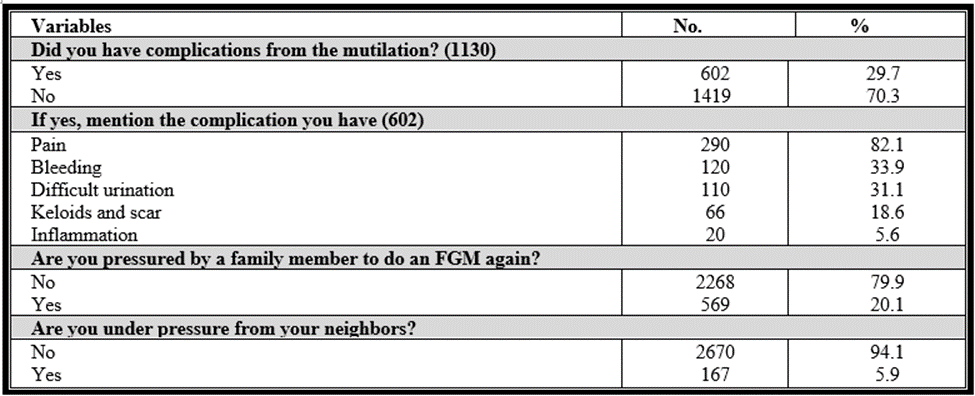
Table (7): Females' exposure to Pressure, and Complication.
Table (8) showed statistically significant relationship between women's intention for mutilation and their exposure to complications or pressure from family and neighbors (plessthan0.001).

Table (8): Relationship between Women's Intention for Mutilation, Exposed to Pressure, And Complication.
*P-value is significant (plessthan0.001) (# more than one answer).
Figure (4) shows the distribution of females according to their reasons for performing and reasons for refusing FGM/C. Traditions and culture was the main reason for performing FGM/C as stated by females (77.4percentage), followed by religious requirements 21.7 percentage, decrease the sexual desire of females (14.4percentage). Health consequences of FGM/C were the main reason stated by females for refusing the procedure (47.3percentage), followed by 10.3percentage of females who stated that FGM/C is not necessary.
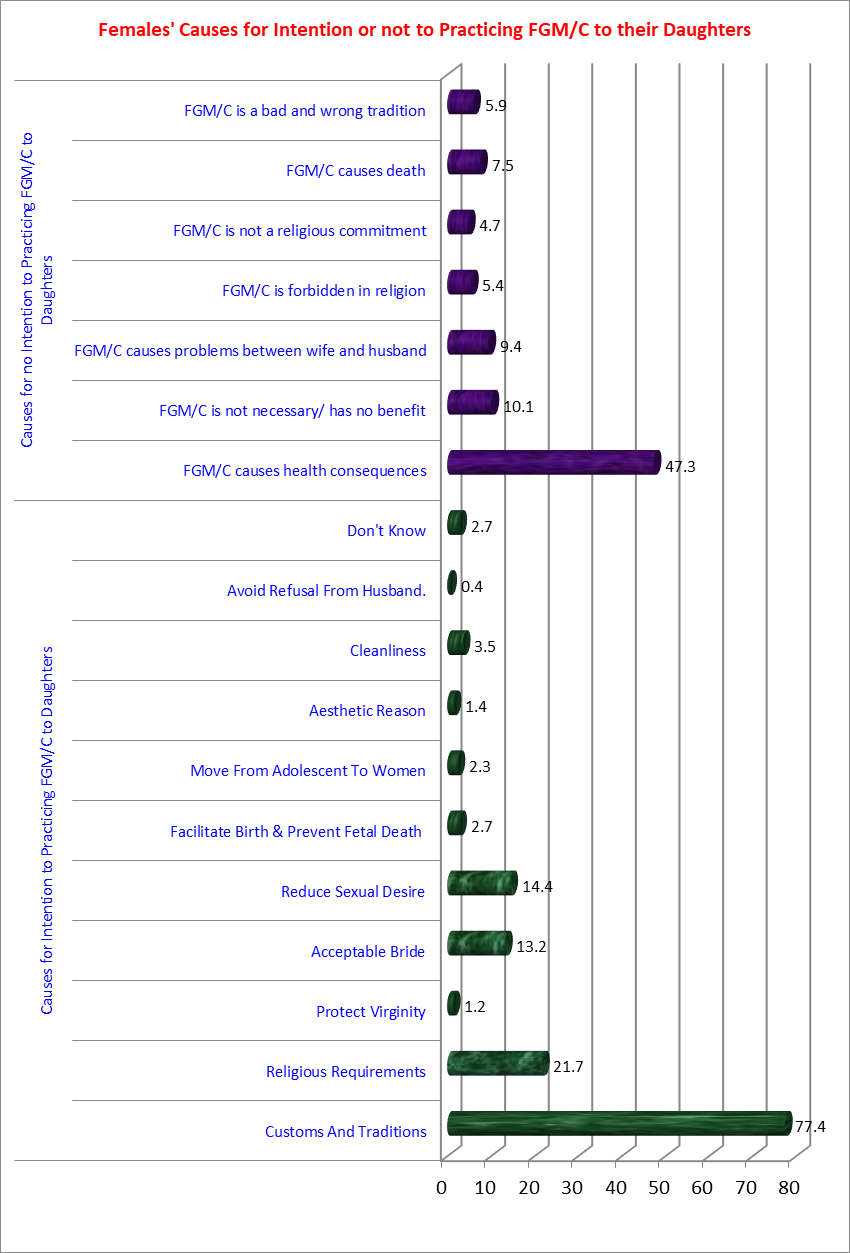
Figure (4): Distribution of Females According to their Causes for Intention or not to Practicing FGM/C.
According to the 2015 Egypt Health Issue Survey (EHIS), the prevalence of FGM/C among females aged 15-19 years was 70percentage, while 80percentage of females aged 20 - 24 had endured FGM/C compared to 89percentage-97percentage of females aged 25-49 who were mutilated. Quite half of the girls aged 1 -14 are probable to experience FGM/C in the future. The prevalence of FGM/C is lower among non-married females compared to ever-married females (68percentage and 93percentage, respectively) [30].
Regarding prevalence of FGM, the presents study revealed that the prevalence of Female Genital Mutilation (FGM/C) at Beni-Suef is 71.4percentage. This result is in accordance with other studies in Upper Egypt that reported that the prevalence of FGC is ranging from 61percentage in Lower Egypt to 97percentage in Upper Egypt. It is practically common in Upper Egypt, with highs of 73.9percentage, 75.5percentage, and 85.5percentage in Beni-Suef, Assiut, and Luxor, respectively [31]. A study conducted among Suhag University students (2015) institute that the prevalence of FGM/C among female students was 86.87percentage [32].
Concerning females' intention in Upper Egypt to perform FGM for their sister or daughter; the results of the current study reveal that, near to one third of females aged 18-60 had the intention to mutilate their daughters. The EHIS statistics showed that two fifth intended to mutilate their daughters, which was higher than the results above [30]. The difference shows advancements in female attitudes, beliefs, and opinions regarding the ending of FGM/C in Egyptian society.
Significant relationships were found between women's intention to practice FGM/C and their level of education, and occupation (p-value lessthan0.001). The results of the present study revealed that their intention decreased with the increase in the level of education. This is close to a study conducted in Iran that revealed that intention decrease with an increased level of education [33]. Moreover, about two fifth of employed female has the intention to practice FGM, while the highest proportion of females who had no intention to practice FGM/C was among student females. This is at odds with a study conducted in UAE that revealed that employed and educated women were less likely to have undergone FGM/C. highlighting the crucial role that women's education plays in efforts to end FGM/C [34].
Female genital mutilation/cutting is seen as a normal part of female socialization in societies that practice it [35]. Regarding statistical relationship between females' intention of mutilating their daughters and their mutilation experience, level of knowledge, and level of attitude, significant statistical relationship was found. About 79.4percentage of females who experienced FGM/C had the intention to mutilate their daughters in the future. This result agrees with a study conducted in Ethiopia, which revealed that the circumcised respondents were nearly three times more likely to intend the continuation of FGM than uncircumcised respondents [36].
Females' intentions to continue performing FGM/C on their daughters were significantly predicted by their prior experience with mutilation, lack of knowledge, an unfavorable attitude, rural residence, and pressure from their families. This was in line with a study conducted in Egypt, which discovered that the desire of females to continue performing FGM/C on their daughters was significantly predicted by the experience of mutilation, lack of education, an unfavorable attitude, and pressure from the spouse [11,37]. In Ethiopia, lack of access to mass media, degree of education, and age all had an impact on women's intentions to undergo FGM or C [38].
The primary sources of information for study's sample regarding FGM were personal experience, friends or neighbors. This is contradicted [39] who conducted research in rural Egypt, found results that contrasted with the findings of the current study because their participants' primary sources of information were radio and television. A significant statistical relationship between women's intention to circumcise their daughters and their source information was found. This highlights the idea that media had an impact on participants' awareness and may be used in delivering the eradication messages required to stop FGM/C practices in Egypt.
A proportional slid of participants are suffering from complications after FGM. They suffered from pain after the surgery, severe bleeding, difficult micturition and keloid and scar from the mutilation. There was an association between women's intention for mutilation and type of complication they have exposed. This expected as bleeding is life threaten. Shabila, et al., (2019) reported that hemorrhage occurs when the arterial blood supply to the genital organs is severed. The hemorrhage can happen right after the procedure or later as a result of a clot sloughing over the blood supply due to the infection [40]. Berg, R. C, 2018 added that severe bleeding after an FGM/C operation can result in a decrease in the volume of circulating blood in the body, leading to hemorrhagic shock. If the female does not receive the emergency help, she requires, she may die soon [41].
Females who were intended to mutilate their daughters in the current study were facing pressure from a family member to perform FGM/C, from their own family or their husband’s family, and neighbors. There was an association between women's intention for mutilation and they're exposed to pressure from family as found by results of the current study. In the present study, about one fifth of females were facing pressure from a family member to perform FGM/C, from their own family or their husband's family, and the minority was facing pressure from a neighbor. One of the main causes of the intention to mutilate daughters was family pressure, according to research done in Upper Egypt to assess how women felt about the prohibition on FGM/C [42,43].
Northern Upper Egyptian Females' Intention regarding intention of mutilating their daughters was significantly affected by demographic characteristics, level of knowledge, and level of attitude, source information, exposure to complications or pressure from family and neighbors
Conflict of interest: The authors have no conflicts of interest to disclose.
Source of funding: The authors did not receive funding for this work.
Clearly Auctoresonline and particularly Psychology and Mental Health Care Journal is dedicated to improving health care services for individuals and populations. The editorial boards' ability to efficiently recognize and share the global importance of health literacy with a variety of stakeholders. Auctoresonline publishing platform can be used to facilitate of optimal client-based services and should be added to health care professionals' repertoire of evidence-based health care resources.

Journal of Clinical Cardiology and Cardiovascular Intervention The submission and review process was adequate. However I think that the publication total value should have been enlightened in early fases. Thank you for all.

Journal of Women Health Care and Issues By the present mail, I want to say thank to you and tour colleagues for facilitating my published article. Specially thank you for the peer review process, support from the editorial office. I appreciate positively the quality of your journal.
Journal of Clinical Research and Reports I would be very delighted to submit my testimonial regarding the reviewer board and the editorial office. The reviewer board were accurate and helpful regarding any modifications for my manuscript. And the editorial office were very helpful and supportive in contacting and monitoring with any update and offering help. It was my pleasure to contribute with your promising Journal and I am looking forward for more collaboration.

We would like to thank the Journal of Thoracic Disease and Cardiothoracic Surgery because of the services they provided us for our articles. The peer-review process was done in a very excellent time manner, and the opinions of the reviewers helped us to improve our manuscript further. The editorial office had an outstanding correspondence with us and guided us in many ways. During a hard time of the pandemic that is affecting every one of us tremendously, the editorial office helped us make everything easier for publishing scientific work. Hope for a more scientific relationship with your Journal.

The peer-review process which consisted high quality queries on the paper. I did answer six reviewers’ questions and comments before the paper was accepted. The support from the editorial office is excellent.

Journal of Neuroscience and Neurological Surgery. I had the experience of publishing a research article recently. The whole process was simple from submission to publication. The reviewers made specific and valuable recommendations and corrections that improved the quality of my publication. I strongly recommend this Journal.

Dr. Katarzyna Byczkowska My testimonial covering: "The peer review process is quick and effective. The support from the editorial office is very professional and friendly. Quality of the Clinical Cardiology and Cardiovascular Interventions is scientific and publishes ground-breaking research on cardiology that is useful for other professionals in the field.

Thank you most sincerely, with regard to the support you have given in relation to the reviewing process and the processing of my article entitled "Large Cell Neuroendocrine Carcinoma of The Prostate Gland: A Review and Update" for publication in your esteemed Journal, Journal of Cancer Research and Cellular Therapeutics". The editorial team has been very supportive.

Testimony of Journal of Clinical Otorhinolaryngology: work with your Reviews has been a educational and constructive experience. The editorial office were very helpful and supportive. It was a pleasure to contribute to your Journal.

Dr. Bernard Terkimbi Utoo, I am happy to publish my scientific work in Journal of Women Health Care and Issues (JWHCI). The manuscript submission was seamless and peer review process was top notch. I was amazed that 4 reviewers worked on the manuscript which made it a highly technical, standard and excellent quality paper. I appreciate the format and consideration for the APC as well as the speed of publication. It is my pleasure to continue with this scientific relationship with the esteem JWHCI.

This is an acknowledgment for peer reviewers, editorial board of Journal of Clinical Research and Reports. They show a lot of consideration for us as publishers for our research article “Evaluation of the different factors associated with side effects of COVID-19 vaccination on medical students, Mutah university, Al-Karak, Jordan”, in a very professional and easy way. This journal is one of outstanding medical journal.
Dear Hao Jiang, to Journal of Nutrition and Food Processing We greatly appreciate the efficient, professional and rapid processing of our paper by your team. If there is anything else we should do, please do not hesitate to let us know. On behalf of my co-authors, we would like to express our great appreciation to editor and reviewers.

As an author who has recently published in the journal "Brain and Neurological Disorders". I am delighted to provide a testimonial on the peer review process, editorial office support, and the overall quality of the journal. The peer review process at Brain and Neurological Disorders is rigorous and meticulous, ensuring that only high-quality, evidence-based research is published. The reviewers are experts in their fields, and their comments and suggestions were constructive and helped improve the quality of my manuscript. The review process was timely and efficient, with clear communication from the editorial office at each stage. The support from the editorial office was exceptional throughout the entire process. The editorial staff was responsive, professional, and always willing to help. They provided valuable guidance on formatting, structure, and ethical considerations, making the submission process seamless. Moreover, they kept me informed about the status of my manuscript and provided timely updates, which made the process less stressful. The journal Brain and Neurological Disorders is of the highest quality, with a strong focus on publishing cutting-edge research in the field of neurology. The articles published in this journal are well-researched, rigorously peer-reviewed, and written by experts in the field. The journal maintains high standards, ensuring that readers are provided with the most up-to-date and reliable information on brain and neurological disorders. In conclusion, I had a wonderful experience publishing in Brain and Neurological Disorders. The peer review process was thorough, the editorial office provided exceptional support, and the journal's quality is second to none. I would highly recommend this journal to any researcher working in the field of neurology and brain disorders.

Dear Agrippa Hilda, Journal of Neuroscience and Neurological Surgery, Editorial Coordinator, I trust this message finds you well. I want to extend my appreciation for considering my article for publication in your esteemed journal. I am pleased to provide a testimonial regarding the peer review process and the support received from your editorial office. The peer review process for my paper was carried out in a highly professional and thorough manner. The feedback and comments provided by the authors were constructive and very useful in improving the quality of the manuscript. This rigorous assessment process undoubtedly contributes to the high standards maintained by your journal.

International Journal of Clinical Case Reports and Reviews. I strongly recommend to consider submitting your work to this high-quality journal. The support and availability of the Editorial staff is outstanding and the review process was both efficient and rigorous.

Thank you very much for publishing my Research Article titled “Comparing Treatment Outcome Of Allergic Rhinitis Patients After Using Fluticasone Nasal Spray And Nasal Douching" in the Journal of Clinical Otorhinolaryngology. As Medical Professionals we are immensely benefited from study of various informative Articles and Papers published in this high quality Journal. I look forward to enriching my knowledge by regular study of the Journal and contribute my future work in the field of ENT through the Journal for use by the medical fraternity. The support from the Editorial office was excellent and very prompt. I also welcome the comments received from the readers of my Research Article.

Dear Erica Kelsey, Editorial Coordinator of Cancer Research and Cellular Therapeutics Our team is very satisfied with the processing of our paper by your journal. That was fast, efficient, rigorous, but without unnecessary complications. We appreciated the very short time between the submission of the paper and its publication on line on your site.

I am very glad to say that the peer review process is very successful and fast and support from the Editorial Office. Therefore, I would like to continue our scientific relationship for a long time. And I especially thank you for your kindly attention towards my article. Have a good day!

"We recently published an article entitled “Influence of beta-Cyclodextrins upon the Degradation of Carbofuran Derivatives under Alkaline Conditions" in the Journal of “Pesticides and Biofertilizers” to show that the cyclodextrins protect the carbamates increasing their half-life time in the presence of basic conditions This will be very helpful to understand carbofuran behaviour in the analytical, agro-environmental and food areas. We greatly appreciated the interaction with the editor and the editorial team; we were particularly well accompanied during the course of the revision process, since all various steps towards publication were short and without delay".

I would like to express my gratitude towards you process of article review and submission. I found this to be very fair and expedient. Your follow up has been excellent. I have many publications in national and international journal and your process has been one of the best so far. Keep up the great work.

We are grateful for this opportunity to provide a glowing recommendation to the Journal of Psychiatry and Psychotherapy. We found that the editorial team were very supportive, helpful, kept us abreast of timelines and over all very professional in nature. The peer review process was rigorous, efficient and constructive that really enhanced our article submission. The experience with this journal remains one of our best ever and we look forward to providing future submissions in the near future.

I am very pleased to serve as EBM of the journal, I hope many years of my experience in stem cells can help the journal from one way or another. As we know, stem cells hold great potential for regenerative medicine, which are mostly used to promote the repair response of diseased, dysfunctional or injured tissue using stem cells or their derivatives. I think Stem Cell Research and Therapeutics International is a great platform to publish and share the understanding towards the biology and translational or clinical application of stem cells.

I would like to give my testimony in the support I have got by the peer review process and to support the editorial office where they were of asset to support young author like me to be encouraged to publish their work in your respected journal and globalize and share knowledge across the globe. I really give my great gratitude to your journal and the peer review including the editorial office.

I am delighted to publish our manuscript entitled "A Perspective on Cocaine Induced Stroke - Its Mechanisms and Management" in the Journal of Neuroscience and Neurological Surgery. The peer review process, support from the editorial office, and quality of the journal are excellent. The manuscripts published are of high quality and of excellent scientific value. I recommend this journal very much to colleagues.

Dr.Tania Muñoz, My experience as researcher and author of a review article in The Journal Clinical Cardiology and Interventions has been very enriching and stimulating. The editorial team is excellent, performs its work with absolute responsibility and delivery. They are proactive, dynamic and receptive to all proposals. Supporting at all times the vast universe of authors who choose them as an option for publication. The team of review specialists, members of the editorial board, are brilliant professionals, with remarkable performance in medical research and scientific methodology. Together they form a frontline team that consolidates the JCCI as a magnificent option for the publication and review of high-level medical articles and broad collective interest. I am honored to be able to share my review article and open to receive all your comments.

“The peer review process of JPMHC is quick and effective. Authors are benefited by good and professional reviewers with huge experience in the field of psychology and mental health. The support from the editorial office is very professional. People to contact to are friendly and happy to help and assist any query authors might have. Quality of the Journal is scientific and publishes ground-breaking research on mental health that is useful for other professionals in the field”.

Dear editorial department: On behalf of our team, I hereby certify the reliability and superiority of the International Journal of Clinical Case Reports and Reviews in the peer review process, editorial support, and journal quality. Firstly, the peer review process of the International Journal of Clinical Case Reports and Reviews is rigorous, fair, transparent, fast, and of high quality. The editorial department invites experts from relevant fields as anonymous reviewers to review all submitted manuscripts. These experts have rich academic backgrounds and experience, and can accurately evaluate the academic quality, originality, and suitability of manuscripts. The editorial department is committed to ensuring the rigor of the peer review process, while also making every effort to ensure a fast review cycle to meet the needs of authors and the academic community. Secondly, the editorial team of the International Journal of Clinical Case Reports and Reviews is composed of a group of senior scholars and professionals with rich experience and professional knowledge in related fields. The editorial department is committed to assisting authors in improving their manuscripts, ensuring their academic accuracy, clarity, and completeness. Editors actively collaborate with authors, providing useful suggestions and feedback to promote the improvement and development of the manuscript. We believe that the support of the editorial department is one of the key factors in ensuring the quality of the journal. Finally, the International Journal of Clinical Case Reports and Reviews is renowned for its high- quality articles and strict academic standards. The editorial department is committed to publishing innovative and academically valuable research results to promote the development and progress of related fields. The International Journal of Clinical Case Reports and Reviews is reasonably priced and ensures excellent service and quality ratio, allowing authors to obtain high-level academic publishing opportunities in an affordable manner. I hereby solemnly declare that the International Journal of Clinical Case Reports and Reviews has a high level of credibility and superiority in terms of peer review process, editorial support, reasonable fees, and journal quality. Sincerely, Rui Tao.

Clinical Cardiology and Cardiovascular Interventions I testity the covering of the peer review process, support from the editorial office, and quality of the journal.

Clinical Cardiology and Cardiovascular Interventions, we deeply appreciate the interest shown in our work and its publication. It has been a true pleasure to collaborate with you. The peer review process, as well as the support provided by the editorial office, have been exceptional, and the quality of the journal is very high, which was a determining factor in our decision to publish with you.
The peer reviewers process is quick and effective, the supports from editorial office is excellent, the quality of journal is high. I would like to collabroate with Internatioanl journal of Clinical Case Reports and Reviews journal clinically in the future time.

Clinical Cardiology and Cardiovascular Interventions, I would like to express my sincerest gratitude for the trust placed in our team for the publication in your journal. It has been a true pleasure to collaborate with you on this project. I am pleased to inform you that both the peer review process and the attention from the editorial coordination have been excellent. Your team has worked with dedication and professionalism to ensure that your publication meets the highest standards of quality. We are confident that this collaboration will result in mutual success, and we are eager to see the fruits of this shared effort.

Dear Dr. Jessica Magne, Editorial Coordinator 0f Clinical Cardiology and Cardiovascular Interventions, I hope this message finds you well. I want to express my utmost gratitude for your excellent work and for the dedication and speed in the publication process of my article titled "Navigating Innovation: Qualitative Insights on Using Technology for Health Education in Acute Coronary Syndrome Patients." I am very satisfied with the peer review process, the support from the editorial office, and the quality of the journal. I hope we can maintain our scientific relationship in the long term.
Dear Monica Gissare, - Editorial Coordinator of Nutrition and Food Processing. ¨My testimony with you is truly professional, with a positive response regarding the follow-up of the article and its review, you took into account my qualities and the importance of the topic¨.

Dear Dr. Jessica Magne, Editorial Coordinator 0f Clinical Cardiology and Cardiovascular Interventions, The review process for the article “The Handling of Anti-aggregants and Anticoagulants in the Oncologic Heart Patient Submitted to Surgery” was extremely rigorous and detailed. From the initial submission to the final acceptance, the editorial team at the “Journal of Clinical Cardiology and Cardiovascular Interventions” demonstrated a high level of professionalism and dedication. The reviewers provided constructive and detailed feedback, which was essential for improving the quality of our work. Communication was always clear and efficient, ensuring that all our questions were promptly addressed. The quality of the “Journal of Clinical Cardiology and Cardiovascular Interventions” is undeniable. It is a peer-reviewed, open-access publication dedicated exclusively to disseminating high-quality research in the field of clinical cardiology and cardiovascular interventions. The journal's impact factor is currently under evaluation, and it is indexed in reputable databases, which further reinforces its credibility and relevance in the scientific field. I highly recommend this journal to researchers looking for a reputable platform to publish their studies.

Dear Editorial Coordinator of the Journal of Nutrition and Food Processing! "I would like to thank the Journal of Nutrition and Food Processing for including and publishing my article. The peer review process was very quick, movement and precise. The Editorial Board has done an extremely conscientious job with much help, valuable comments and advices. I find the journal very valuable from a professional point of view, thank you very much for allowing me to be part of it and I would like to participate in the future!”

Dealing with The Journal of Neurology and Neurological Surgery was very smooth and comprehensive. The office staff took time to address my needs and the response from editors and the office was prompt and fair. I certainly hope to publish with this journal again.Their professionalism is apparent and more than satisfactory. Susan Weiner

My Testimonial Covering as fellowing: Lin-Show Chin. The peer reviewers process is quick and effective, the supports from editorial office is excellent, the quality of journal is high. I would like to collabroate with Internatioanl journal of Clinical Case Reports and Reviews.

My experience publishing in Psychology and Mental Health Care was exceptional. The peer review process was rigorous and constructive, with reviewers providing valuable insights that helped enhance the quality of our work. The editorial team was highly supportive and responsive, making the submission process smooth and efficient. The journal's commitment to high standards and academic rigor makes it a respected platform for quality research. I am grateful for the opportunity to publish in such a reputable journal.
My experience publishing in International Journal of Clinical Case Reports and Reviews was exceptional. I Come forth to Provide a Testimonial Covering the Peer Review Process and the editorial office for the Professional and Impartial Evaluation of the Manuscript.
